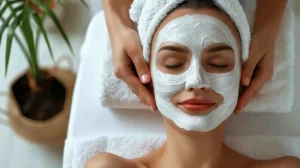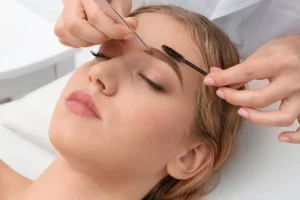Smooth, radiant skin is a common goal for many, but achieving it can be challenging. For a flawless complexion, two popular exfoliation techniques have emerged: dermaplaning and microdermabrasion. While both aim to remove dead skin cells and reveal a fresher, more vibrant appearance, their methods and potential benefits differ. Knowing the distinctions between these two treatments is crucial for making an informed decision about which one best suits your individual skin needs.
What is Dermaplaning?
Dermaplaning is a manual exfoliation approach that uses a sterile, surgical blade to gently scrape off the uppermost layer of dead skin cells and fine vellus hair (peach fuzz) from the face.
During the process, the practitioner holds the blade at a precise angle and carefully glides it across the skin, removing the accumulated debris and unwanted hair. Dermaplaning is often described as a physical exfoliation method that provides immediate results, revealing a smoother, brighter complexion.
One of the primary benefits of dermaplaning is its ability to eliminate the buildup of dull, dry skin cells that can make the complexion appear lackluster. By removing this outer layer, newer, fresher skin cells can surface, resulting in a more radiant and even-toned appearance. Removing fine facial hair can make the skin feel softer, allowing for better product absorption.
What is Microdermabrasion?
Microdermabrasion is a non-invasive cosmetic procedure that uses a handheld device to gently exfoliate the skin’s surface. Unlike dermaplaning, which uses a surgical blade, microdermabrasion employs a combination of fine crystals or a diamond-tipped wand to mechanically remove the outermost layer of dead skin cells.
During the treatment, the microdermabrasion device is passed over the skin, and the wand’s crystals or abrasive surface works to slough off the dull, damaged cells. Simultaneously, a vacuum suction mechanism collects the loosened debris, ensuring a clean and controlled process.
Microdermabrasion is known for improving skin texture and tone by reducing the appearance of fine lines, age spots, acne scars, and other blemishes. Removing the topmost layer of skin stimulates the production of new collagen and elastin, resulting in a fresher, more youthful complexion.
One of the advantages of microdermabrasion is that it can be customized to address specific skin concerns and sensitivity levels. The intensity of the treatment can be adjusted by varying the pressure, crystal flow, or wand coarseness, making it suitable for most skin types.
Dermaplaning vs Microdermabrasion
While both techniques aim to improve skin appearance and texture through exfoliation, they differ in several key aspects:
Method of Exfoliation:
- Dermaplaning: A sterile surgical blade manually scrapes away the outermost layer of dead skin cells and fine hair (peach fuzz).
- Microdermabrasion: Employs a mechanical device with abrasive crystals or a diamond-tipped wand to slough off dead cells.
Depth of Exfoliation:
- Dermaplaning targets only the very surface layer of the skin.
- Microdermabrasion can penetrate slightly deeper, depending on treatment intensity.
Targeted Skin Concerns:
- Dermaplaning excels in addressing dullness and uneven texture and removing fine facial hair.
- Microdermabrasion is more effective for reducing fine lines, age spots, acne scarring, and hyperpigmentation.
Downtime and Recovery:
- Dermaplaning typically requires little to no downtime, with immediate visible results.
- Microdermabrasion may involve a slightly longer recovery period, with temporary redness or mild irritation lasting a day or two.
Cost and Accessibility:
- Dermaplaning is generally considered more affordable than microdermabrasion.
- Microdermabrasion often requires multiple sessions for optimal results, increasing the overall cost.
Choosing the Right Treatment for Your Skin
Dermaplaning is a tried-and-true, cost-effective solution for enhancing your skin’s overall complexion. This manual exfoliation technique effectively removes dead skin cells and unwanted facial hair, revealing a smoother, brighter appearance. For most individuals seeking a refreshed and more radiant look, dermaplaning can be a reliable choice that delivers noticeable results without breaking the bank.
However, microdermabrasion may be the way to go if you’re aiming for the ultimate in skin rejuvenation and a truly transformed complexion. This advanced exfoliation method penetrates deeper into the skin’s layers, effectively addressing a broader range of concerns such as fine lines, age spots, acne scarring, and hyperpigmentation. With its ability to stimulate collagen production and improve skin texture and tone, microdermabrasion offers a comprehensive solution for achieving a smoother, more youthful, and radiant appearance.
While microdermabrasion typically requires a higher investment in cost and multiple treatment sessions, the results can be remarkable for those seeking a more intensive skin rejuvenation experience.
Aftercare and Maintenance
Proper aftercare and maintenance are crucial for maximizing the benefits of both dermaplaning and microdermabrasion treatments and ensuring long-lasting results.
Post-Treatment Skincare Routine:
- Dermaplaning: After the treatment, your skin may be more sensitive to irritation. Follow a gentle skincare routine, avoiding harsh products or exfoliants for at least 24-48 hours. Apply a soothing moisturizer and sun protection (SPF 30 or higher).
- Microdermabrasion: Following a microdermabrasion session, your skin may experience temporary redness, mild swelling, or sensitivity. A gentle, non-irritating cleanser and a hydrating moisturizer can help soothe and nourish the skin during recovery. Sun protection is also crucial to prevent further damage or discoloration.
Frequency of Treatments:
- Dermaplaning: Depending on your skin type and hair growth rate, dermaplaning treatments can typically be repeated every 4-6 weeks.
- Microdermabrasion: For optimal results, microdermabrasion treatments are often recommended every 2-4 weeks, with a series of 6-12 sessions for more significant concerns.
Combining with Other Skincare Treatments or Products:
- Dermaplaning can be combined with other non-invasive treatments, such as chemical peels or facials, to enhance overall skin health and appearance.
- Microdermabrasion can be complemented with professional-grade skincare products containing active ingredients like retinoids, vitamin C, or alpha-hydroxy acids to improve skin texture and tone further.
Takeaway
Whether you choose the affordable and effective dermaplaning option or opt for the transformative power of microdermabrasion, you can trust Avia Medical Spa to provide exceptional service and outstanding results.
Don’t settle for dull, lackluster skin any longer. Schedule your assessment at Avia Medical Spa today to take the first step towards a glowing, rejuvenated appearance. Our experts will guide you through the process, ensuring you receive the best exfoliation treatment to reveal your most beautiful, radiant self.
Invest in your skin’s health and confidence – book your appointment now and experience the Avia Medical Spa difference.



